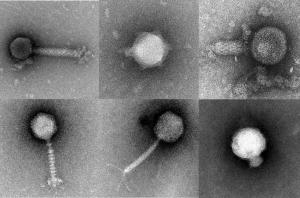UH marine scientists collaborate on $3 million NSF grant to investigate aquatic viruses
University of Hawaiʻi at MānoaProfessor, Oceanography, School of Ocean and Earth Science and Technology
Kyle Edwards, (808) 956-6198
Assistant Professor, Oceanography, School of Ocean and Earth Science and Technology
University of Hawai‘i at Mānoa oceanographers Grieg Steward and Kyle Edwards, as part of a research team from four universities, received a $3 million grant to probe how viruses impact microbes critical to our lives — from producing oxygen to growing food.
The four-year project is supported by the National Science Foundation’s (NSF) Established Program to Stimulate Competitive Research (EPSCoR). This collaboration is among eight projects across the U.S., totaling $41.7 million, that aim to build U.S. research capacity in understanding the relationship in organisms between their genes and their physical characteristics. Uncovering this genotype-to-phenotype relationship holds potential for improved crop yields, better prediction of human disease risk and new drug therapies.
"Over the past several decades, scientists and engineers have made massive strides in decoding, amassing and storing genomic data," said Denise Barnes, NSF EPSCoR head in a press release. "But understanding how genomics influence phenotype remains one of the more profound challenges in science. These awards lay the groundwork for closing some of the biggest gaps in biological knowledge and developing interdisciplinary teams needed to address the challenges."
Environmental microbes
From water and soil to the human gut, single-celled microbes abound — and viruses are present right alongside them. A virus will infect a microbe, hijack its machinery and begin replicating, eventually killing the host. But how these processes work within complex microbial communities is still largely a mystery.
Steward, Edwards and collaborators will focus their research on viruses that infect phytoplankton: microscopic organisms that live in ocean water and freshwater, and conduct photosynthesis. Phytoplankton serve as the base of marine and freshwater food chains and produce more than half the oxygen on Earth. Viruses are a major source of mortality for phytoplankton, and have complex but poorly understood effects on the physiology and evolution of their hosts.
Steward and Edwards will investigate a diverse collection of phytoplankton-virus systems that Steward’s group has isolated from waters around Oʻahu.
“These include viruses infecting branches of the tree of life from which viruses had never been isolated, as well as some of the largest known viruses,” said Edwards. “We will also perform laboratory evolution experiments, aiming to unravel the intricate host-virus dynamics that often resemble molecular arms races.”
A nano-lab for observing viruses and cells
One of the goals of the multi-university collaboration is to develop new technology to enable scientists to examine (in a droplet of water smaller than mist) how a single virus and a single microbial cell interact. They aim to make new tools and resources in microfluids technology available to the broader scientific community.
“Imagine doing a classic microbiology experiment with test tubes and culture plates. Our research would take all of those test tubes and cultures and reduce them down to a tiny droplet 100 times smaller than the diameter of a human hair,” said K. Eric Wommack from the University of Delaware (UD) who will lead the team of marine scientists.
Operating under the principle that oil and water don’t mix, the interdisciplinary team will create devices the size of a microscope slide, equipped with tiny incubation chambers filled with oil, to isolate individual droplets of water injected with a syringe. Molds for these microfluidic devices will be fabricated in UD’s state-of-the-art Nanofabrication Facility for collaborators including Steward and Edwards.
The research team also will create the Viral Informatics Resource for Genome Organization (VIRGO) to manage troves of genomic data on viruses and make inferences about how unknown viral populations might behave.
* * *
Project collaborators include K. Eric Wommack at the University of Delaware (lead); Marcia Marston and Koty Sharp at Roger Williams University; Grieg Steward and Kyle Edwards at the University of Hawai‘i at Mānoa; and David Dunigan and Jim Van Etten at the University of Nebraska-Lincoln.

